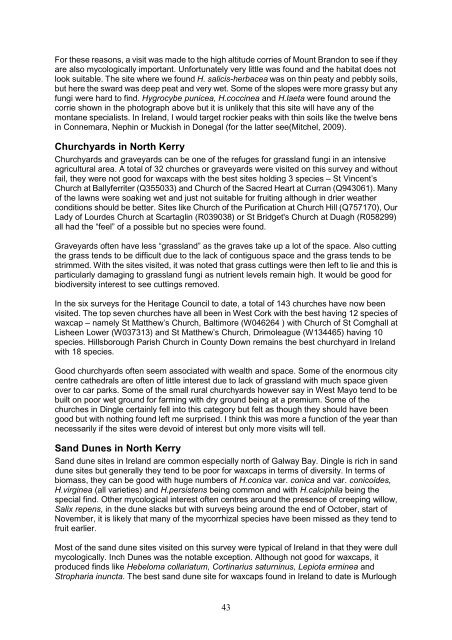North Kerry Waxcap Survey 2012 - the Northern Ireland Fungus Group
North Kerry Waxcap Survey 2012 - the Northern Ireland Fungus Group
North Kerry Waxcap Survey 2012 - the Northern Ireland Fungus Group
You also want an ePaper? Increase the reach of your titles
YUMPU automatically turns print PDFs into web optimized ePapers that Google loves.
For <strong>the</strong>se reasons, a visit was made to <strong>the</strong> high altitude corries of Mount Brandon to see if <strong>the</strong>y<br />
are also mycologically important. Unfortunately very little was found and <strong>the</strong> habitat does not<br />
look suitable. The site where we found H. salicis-herbacea was on thin peaty and pebbly soils,<br />
but here <strong>the</strong> sward was deep peat and very wet. Some of <strong>the</strong> slopes were more grassy but any<br />
fungi were hard to find. Hygrocybe punicea, H.coccinea and H.laeta were found around <strong>the</strong><br />
corrie shown in <strong>the</strong> photograph above but it is unlikely that this site will have any of <strong>the</strong><br />
montane specialists. In <strong>Ireland</strong>, I would target rockier peaks with thin soils like <strong>the</strong> twelve bens<br />
in Connemara, Nephin or Muckish in Donegal (for <strong>the</strong> latter see(Mitchel, 2009).<br />
Churchyards in <strong>North</strong> <strong>Kerry</strong><br />
Churchyards and graveyards can be one of <strong>the</strong> refuges for grassland fungi in an intensive<br />
agricultural area. A total of 32 churches or graveyards were visited on this survey and without<br />
fail, <strong>the</strong>y were not good for waxcaps with <strong>the</strong> best sites holding 3 species – St Vincent’s<br />
Church at Ballyferriter (Q355033) and Church of <strong>the</strong> Sacred Heart at Curran (Q943061). Many<br />
of <strong>the</strong> lawns were soaking wet and just not suitable for fruiting although in drier wea<strong>the</strong>r<br />
conditions should be better. Sites like Church of <strong>the</strong> Purification at Church Hill (Q757170), Our<br />
Lady of Lourdes Church at Scartaglin (R039038) or St Bridget's Church at Duagh (R058299)<br />
all had <strong>the</strong> “feel” of a possible but no species were found.<br />
Graveyards often have less “grassland” as <strong>the</strong> graves take up a lot of <strong>the</strong> space. Also cutting<br />
<strong>the</strong> grass tends to be difficult due to <strong>the</strong> lack of contiguous space and <strong>the</strong> grass tends to be<br />
strimmed. With <strong>the</strong> sites visited, it was noted that grass cuttings were <strong>the</strong>n left to lie and this is<br />
particularly damaging to grassland fungi as nutrient levels remain high. It would be good for<br />
biodiversity interest to see cuttings removed.<br />
In <strong>the</strong> six surveys for <strong>the</strong> Heritage Council to date, a total of 143 churches have now been<br />
visited. The top seven churches have all been in West Cork with <strong>the</strong> best having 12 species of<br />
waxcap – namely St Mat<strong>the</strong>w’s Church, Baltimore (W046264 ) with Church of St Comghall at<br />
Lisheen Lower (W037313) and St Mat<strong>the</strong>w’s Church, Drimoleague (W134465) having 10<br />
species. Hillsborough Parish Church in County Down remains <strong>the</strong> best churchyard in <strong>Ireland</strong><br />
with 18 species.<br />
Good churchyards often seem associated with wealth and space. Some of <strong>the</strong> enormous city<br />
centre ca<strong>the</strong>drals are often of little interest due to lack of grassland with much space given<br />
over to car parks. Some of <strong>the</strong> small rural churchyards however say in West Mayo tend to be<br />
built on poor wet ground for farming with dry ground being at a premium. Some of <strong>the</strong><br />
churches in Dingle certainly fell into this category but felt as though <strong>the</strong>y should have been<br />
good but with nothing found left me surprised. I think this was more a function of <strong>the</strong> year than<br />
necessarily if <strong>the</strong> sites were devoid of interest but only more visits will tell.<br />
Sand Dunes in <strong>North</strong> <strong>Kerry</strong><br />
Sand dune sites in <strong>Ireland</strong> are common especially north of Galway Bay. Dingle is rich in sand<br />
dune sites but generally <strong>the</strong>y tend to be poor for waxcaps in terms of diversity. In terms of<br />
biomass, <strong>the</strong>y can be good with huge numbers of H.conica var. conica and var. conicoides,<br />
H.virginea (all varieties) and H.persistens being common and with H.calciphila being <strong>the</strong><br />
special find. O<strong>the</strong>r mycological interest often centres around <strong>the</strong> presence of creeping willow,<br />
Salix repens, in <strong>the</strong> dune slacks but with surveys being around <strong>the</strong> end of October, start of<br />
November, it is likely that many of <strong>the</strong> mycorrhizal species have been missed as <strong>the</strong>y tend to<br />
fruit earlier.<br />
Most of <strong>the</strong> sand dune sites visited on this survey were typical of <strong>Ireland</strong> in that <strong>the</strong>y were dull<br />
mycologically. Inch Dunes was <strong>the</strong> notable exception. Although not good for waxcaps, it<br />
produced finds like Hebeloma collariatum, Cortinarius saturninus, Lepiota erminea and<br />
Stropharia inuncta. The best sand dune site for waxcaps found in <strong>Ireland</strong> to date is Murlough<br />
43


